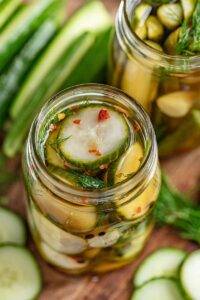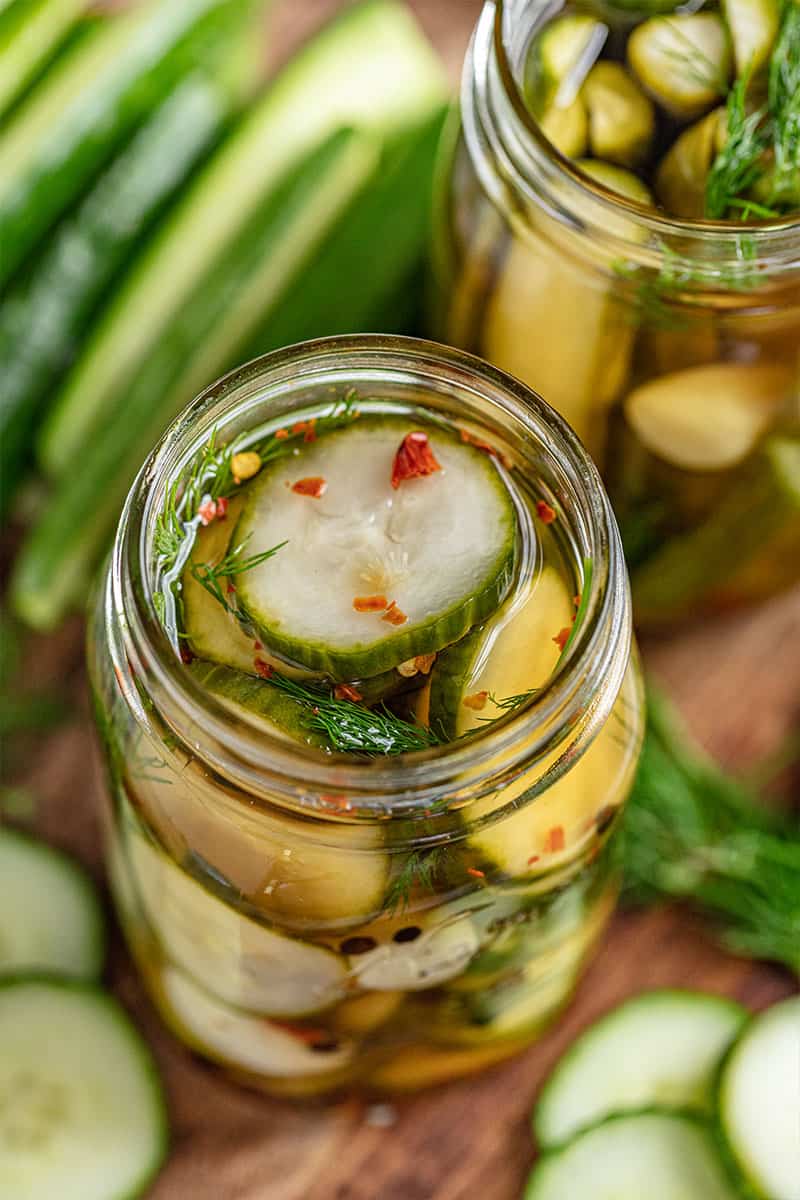Pickles from the refrigerator have the ideal balance of salty, tangy flavor and the best crunch.
Making pickles at home is going to be so much fun!
Everyone loves pickles, so they’re not just for pregnant women to satisfy their midnight cravings! They also taste so much better when made at home, like most things! You shouldn’t be intimidated because cooking pickles is so simple and quick.
You won’t ever use that jar from the store again!
History Lesson: Pickles have been around since ancient times, when pickling was the finest method of food preservation.
When you hear the word “pickles,” you might immediately picture cucumbers, but virtually any vegetable can be pickled!
Pickling options for cucumbers include regular cucumbers, which are the typical grocery store cucumbers that are short and wide and may even have a waxy covering to help them appear nice on the shelf. These have more water in them and larger seeds.
Since English cucumbers lack a wax coating, they are frequently wrapped in plastic to keep them fresher longer on the market.
They are ideal for refrigerator pickles because they have a sweeter flavor and, although they still have seeds, they are tiny and contain a lot less water.
Pickling Pickling cucumbers is their natural habitat.
Although they can be eaten directly from the garden, their extra-crunchy meat and thin skin make them perfect for pickling.
It could be challenging to locate these in a store.
You can even use small cucumbers if English or pickling cucumbers are hard to come by.
BREAD AND BUTTER PICKLES
Love Bread and Butter pickles? No problem! It’s easy to alter this dill pickle recipe to the bread and butter variety. Simply replace 1/2 cup of the white vinegar with apple cider vinegar.
Then, instead of adding in black peppercorns, garlic, and dill you’ll flavor the pickles with:
Cinnamon stick, 1 inch
Whole mustard seeds in a teaspoon
6 berries of allspice
6 complete cloves
One-half teaspoon of ground turmeric
ADVOCATE FOR SUGAR:
In terms of food safety, it is true that you can live without the sugar, but we don’t advise it.
Sugar balances out the tartness in this amount of acidity and aids in texture preservation when used in pickling.

Making a considerably larger batch of pickles may be a good idea if you want to can them.
Pickles and brine should be put into pint-sized sterilized canning jars, leaving 1/2 inch of headspace.
Make sure to cleanly wipe the rim before using a canning lid and ring to seal it.
Avoid overtightening.
Put in a big stockpot to can in. Process in a water bath for 15 minutes, covering the tops of the jars with at least 1 inch of water (higher elevations and/or larger jars will require a longer processing time).
Carefully take the jars from the water bath, and then leave them to sit on the counter for 24 hours without being touched.
Each jar should sound like it is sealing when you hear a ping.
By gently tapping the top of the lid after 24 hours, ensure sure the jars have properly sealed.
When you squeeze the center, if it bubbles up and down, it has not sealed and needs to be either refrigerated or reprocessed.
The jar is properly sealed if the lid is firm, and it can be kept in the pantry.
INGREDIENTS
1 English cucumber
1 1/2 cups white vinegar
2 tablespoons sugar
1 tablespoon table salt
1 teaspoon whole black peppercorns
3 cloves garlic
3 sprigs fresh dill
INSTRUCTIONS
Cut cucumbers into spears or slices.
Use a mason jar or another airtight container to store the cucumbers.
Stir the vinegar, sugar, salt, peppercorns, and garlic in a small saucepan. up to a boil.
After simmering, turn off the heat.
Fill container with cucumbers by pouring mixture over them.
When the container is cold enough to handle, cover it.
Put fresh dill in once it has cooled.
Eat the following day after refrigeration.
NOTES
Regular cucumbers, English cucumbers, pickled cucumbers, or tiny cucumbers can all be used in this recipe. Depending on your desire, you can slice or chop each of these into wedges.
powerful pickles This recipe yields a pickle with a powerful flavor.
You can substitute water for up to half of the vinegar if you prefer a milder kick.
Apple cider vinegar can be used in place of 1/2 cup of the white vinegar in the variation on bread & butter pickles.
As a substitute for the black peppercorns, garlic, and dill, use the following to flavor the pickles:
Cinnamon stick, 1 inch
Whole mustard seeds in a teaspoon
6 berries of allspice
6 complete cloves
One-half teaspoon of ground turmeric
Add 1/4 to 1/2 teaspoon of red pepper flakes crushed to the pickling liquid for a spicy variation.
